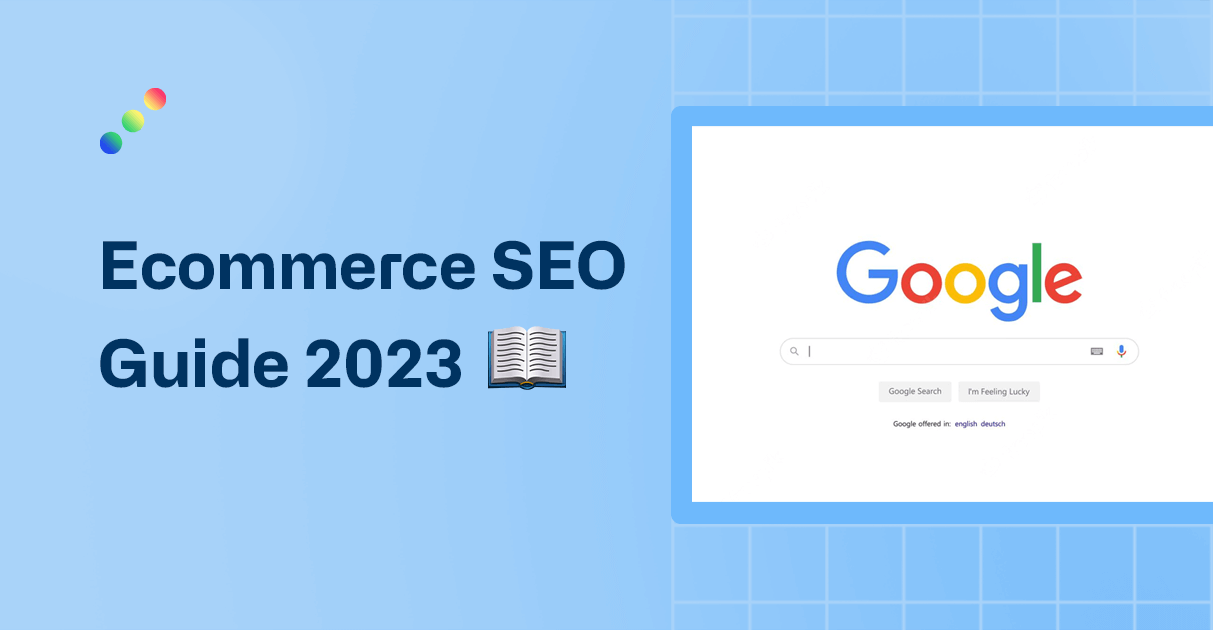Did you know that, according to nChannel, 44% of people with buy intent start their online shopping journey by searching on Google?
Even though of any eCommerce marketing channel on the internet, SEO has the highest ROI.
Still, most online shops are neglecting to fight for their space in the search results.
Instead, we rely on paid and social media ads mostly.
This is great, I agree, and many businesses are profitable with ads. Still, it requires a constant effort and stream of income which we have to reinvest further.
How would it be if we didn’t need to spend our income mostly on Ads?
Well, we don’t because Ecommerce SEO only requires effort upfront.
Once your website ranks on Google, you’re practically making sales on autopilot with no need to spend your money on Ads.
That’s a simplification, of course, but it’s also not far away from the truth.
Doesn’t this idea make you drool?
Yet many eCommerce and Dropshipping owners have no intent in implementing SEO to boost their website organic traffic or can’t find proper strategies to implement.
Don’t worry. We’re here to assist. If you have the willpower to grow your organic traffic, everything else will come to its place.
In this article, we’re going to provide you with a full Ecommerce SEO guide on optimizing your online store to grow organic traffic and drive more sales.
Grab a coffee, and let’s get started!
What Ecommerce SEO Is and Why It Is so Important?
Search engine optimization(SEO) is a process of optimizing your website around some keywords that people search for to generate organic traffic.
Optimizing a website is creating and offering the best possible results for the target keywords.
When searching for something on Google, you get the search engine results page(SERP):
Google’s goal is to answer all of the searcher’s queries and questions in the best possible way, so users don’t have to search anymore.
For this reason, what Google does is show the best possible answers for the users’ search queries.
So, the question is, how can you provide your eCommerce store to be the most relevant result?
To do that, you should:
- Answer the questions and queries around some topic to solve searchers’ concrete problems or offer them a solution.
- Provide a better user experience with a faster site, a better mobile experience, a more intuitive interface, etc.
- Get people talking about you and sharing your products and content.
For eCommerce businesses, this usually means:
- Writing great product descriptions.
- Including high-quality and beautiful photos.
- Providing customer reviews to help your visitors make a proper purchase decision.
- Providing an easy purchase for customers by making the buttons and font big enough.
- Keeping your site glitch-free.
In search results, Google first displays a few Ads. Then below, they show the organic results. Most of the clicks are still coming through the organic results.
However, it varies depending on the number and quality of ads and the keyword.
You can get many extra sales per month, all for free, with just a little extra SEO effort.
But enough theory, let’s talk about how to do it practically!
Step 1. Do Keyword Research for eCommerce SEO
Keyword research for eCommerce SEO is the first step in the optimization process. Because you’re in the eCommerce industry, the focus of your pages should be on high buyer intent keywords.
Buyer intent means how far along someone is in their decision to buy.
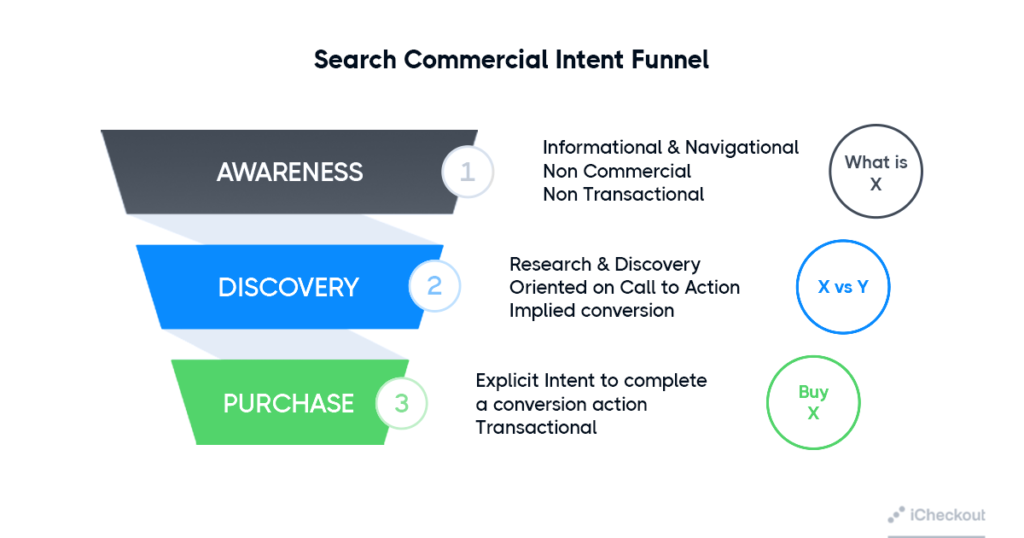
For example, if someone searches for “best sports clothes,” – this person is in the research process, and they are probably not yet ready to buy.
They probably want to read product reviews and compare the features and benefits of different sports clothing brands.
But if they’re searching for “Nike sports clothes,” they’re probably looking for the best deal on the internet. This means that they’re more likely to buy.
What’s great is that you don’t have to guess the buyer’s intent.
What you have to do is to identify those high-value search queries and terms that your potential customers are probably using. You can conduct keyword research in several different ways.
You need to realize that keyword research for eCommerce SEO is different from keyword research for other businesses.
Why is that?
Most sites are trying to find information keywords and rank for them:
While you, on the other hand, need to rank your store for commercial keywords such as:
Can you spot a difference?
Information keyword searchers are looking for answers, information, etc. Blogs and sites that create content for their potential clients care about these keywords.
On the other side, eCommerce sites are striving to rank for commercial keywords that include buying intent in themselves.
So, how to find those commercial keywords, you wonder?
Amazon Suggest
Amazon is the biggest eCommerce site on the internet, making it an excellent place for finding high buyer intent keywords. People come there to buy only, so there are no informational keywords.
To find your keywords, go to Amazon and enter a keyword that describes one of your products, for example:
The keywords Amazon suggests are usually very targeted (also known as long-tail keywords).
Not only do long-tail keywords usually convert better than short-tail ones, but in many cases, they’re less competitive.
Do this for the essential products on your site.
Pro Tip: Sometimes, Amazon will suggest categories above the keyword suggestions. These keywords are great to use for category pages. It will help your store rank better for these keywords, and it will cause a better user experience.

One great tool that can help you find and list all the keywords from Amazon is Keyword Tool Dominator.
This helpful tool automatically scrapes Amazon’s autofill suggestions for any keyword you type in the search bar. It will drastically reduce your effort for research on Amazon.
Not only this tool helps you find more long-tail keywords, but it can also give you a bunch of keyword ideas.
You can use two free searches per day in a free version, but this can help you find dozens of exciting keyword suggestions.
Just by typing “motorcycle helmets,” we got 266 keywords in a second.
Isn’t that great?
You can easily download the list as a CSV file and include it on your keyword list for later.
Google Keyword Planner
While most searches happen on Google, there is a Google Keyword Planner(GKP) tool for researching our potential keywords.
For example, in case you input a keyword such as “motorcycle helmets” into the search bar, you’ll get some variations of that term:
Start digging a bit through those suggested keywords. You can find some extra keywords easier to rank for that aren’t straight-up variations of the keyword you just typed in.
In Google Keyword Planner, you can see the average monthly searches for each keyword.
A competition section also shows how competitive bids are for each keyword in Google Ads.
To determine the buyer intent of a keyword, you should check out the Top of Page Bid, which shows how much advertisers spend on a single click for paid ads.
The higher the bid is for each keyword, the higher the commercial intent is.
Analyze Your Competitors
Searching for potential keywords on Google, Amazon, and GKP is excellent. However, before you start optimizing your store and content, it’s important to check what your competitors do.
At the end of the day, they are the ones that we’re striving to outperform on Google. So the great start to start competing is by competing for the keywords they’re already ranking for.
So, let’s see how to identify those keywords.
SemRush
SemRush is an SEO tool that analyzes keywords, search volume, number of results, competition level, and other related keywords.
By entering an exact keyword into the search bar and hitting enter, you’ll be able to see almost everything you need for future SEO execution, such as:
- Monthly search volume for each country – the number of monthly searches separately for each country
- Global search volume – number of searches worldwide in global
- Keyword difficulty – shows how hard it is to rank on the first page for this keyword (from 1-100)
- The trend of searches for each keyword
- Keyword variations and related keywords
- Search results and websites that already rank for this keyword
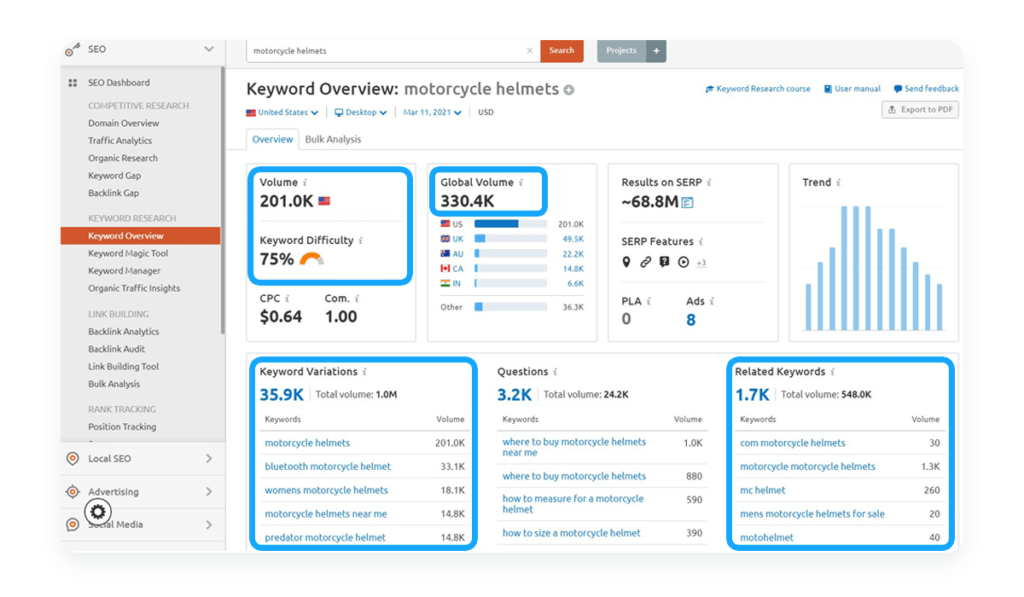
This in-depth analysis will help you determine what keywords you should rank for and from where to start, which we’ll soon talk about.
You may also use SemRush to research your competitors and the keywords that they rank for.
For example, if we want to check what our competitors are ranking for, what we should do is enter their website URL into the search bar:

Here we’re able to see our competitors:
- Authority score – a metric for measuring the overall quality of the domain and its influence on SEO(the higher it is – the better)
- Organic Search Traffic – The number of monthly site visitors
- Backlinks – the number of the domain’s backlinks coming from other domains
- Number of keywords they rank for and much more valuable data we could use to our benefit
What’s great is that by using SemRush, you can see all the keywords your competitors are ranking for.
Just after you enter your competitor’s URL into the search bar and hit the Search button, click Organic Research and then Positions.

You’ll notice several metrics for keywords that your competitors are ranking for, such as:
- What position they’re ranking on for each keyword
- Search volume of those keywords
- The difficulty of those keywords
- Percentage of traffic they get through SERP for each keyword

If you want to export these keywords into the CSV file, you can do it quickly. Just click Export in the upper right above the table, and you’ll have a bunch of new keywords in one place.
Click on the Competitors segment to identify more competitors and keywords they rank for.

It will help you identify new competitors, their organic traffic share, the number of keywords they rank for, and other helpful information.
If you want to see what keywords they are ranking for and other information, just insert their URL into the search bar, hit Search, and repeat the whole process above.
To help you store all these keywords into one file, we created a sheet for better managing the keywords you identify.
Step 2. Choose the Right Keywords for Your Store
I suppose that you have a pretty extensive list of potential keywords now.
You’re probably wondering which keywords you should use for the website.
To help you narrow down and choose the keywords that matter, you should focus on a few key factors.
1. Search Volume
I guess you’re aware that search volume is one of the most important factors for evaluating Ecommerce SEO keywords. The higher the volume is, the more potential traffic to your site.
High-volume keywords are usually short-tails(1-2 words in a phrase), while long-tail keywords have 2+ words in themselves, and they are usually not high-volume.
Still, these words lead to more conversions.
High-volume and low-volume also depend on the industry. Not all industries are equally searchable on Google.
How to find the search volume for each keyword?
You can use various tools(we’ll list some of them later) to find the search volume of each keyword from the list. Just put it in the search bar of any tool, and hit enter.
There you’ll get the number of average volume searches, keyword difficulty, and other information that will help you choose the keywords you want to rank for.
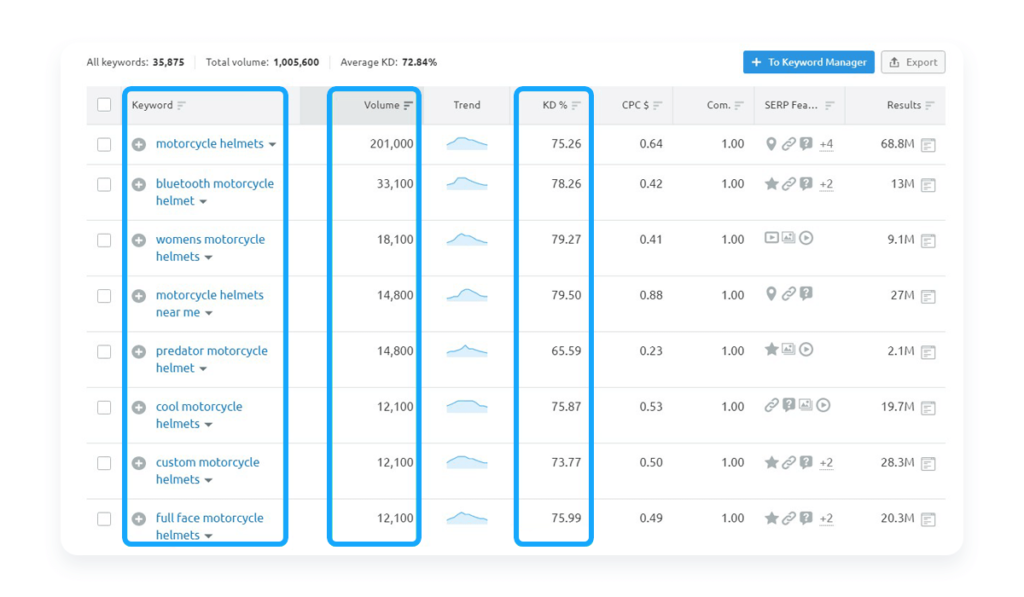
Make sure to put in the sheet with your keywords or export it from your tool.
2. Search intent
Since you want to target keywords that show buyer intent, you first need to decide on each keyword’s intent. Usually, you can do it just by looking at a keyword.
For example, try to guess which one of these two keywords has more buyer intent:
“shoei neotec 2 black” OR “modular motorcycle helmets”
Which one of these two words is more likely to make visitors buy?
The first one, of course. Because the first person is searching for a specific helmet model, looking at its reviews – if he likes it, if the price is okay, he will probably buy it.
On the other side, the second person is still researching motorcycle helmets and still hasn’t decided which one he wants to buy.
So before you decide on a keyword you want to rank for, check if people using that keyword wish to buy something or they’re just browsing.
Let me show you two ways to check search intent.
1. Google it
This strategy can also be used to create optimized content, pages, etc. We want to check search intent for the keyword “shoei neotec 2 black” and what content our page needs to offer for this keyword.
Googling it, this is what we get:
All of these results are product pages(sales pages). If these are the best-ranked pages for this keyword by Google, it means that those are the most relevant pages.
We might conclude that this keyword has a buyer intent, and this keyword we might use for the product page in case we sell this model of helmet.
While for the “modular motorcycle helmets,” this is what we get as a result:
All of these pages are category pages with several products.
Here the buyer intent is much lower, and the searcher is just browsing for helmets – not yet ready to buy.
I guess you get the point.
Note: You can do this for each of your pages. To check what kind of content your page needs to provide for each keyword, google it and check the top result pages.
And you can go vice versa – to find keywords you’re going to use for each page, see what kind of content you get by googling it.
2. Google Keyword Planner
Using Google Keyword Planner, you can quickly check search intent.
How?
First, check out the keyword’s “Competition” rating.
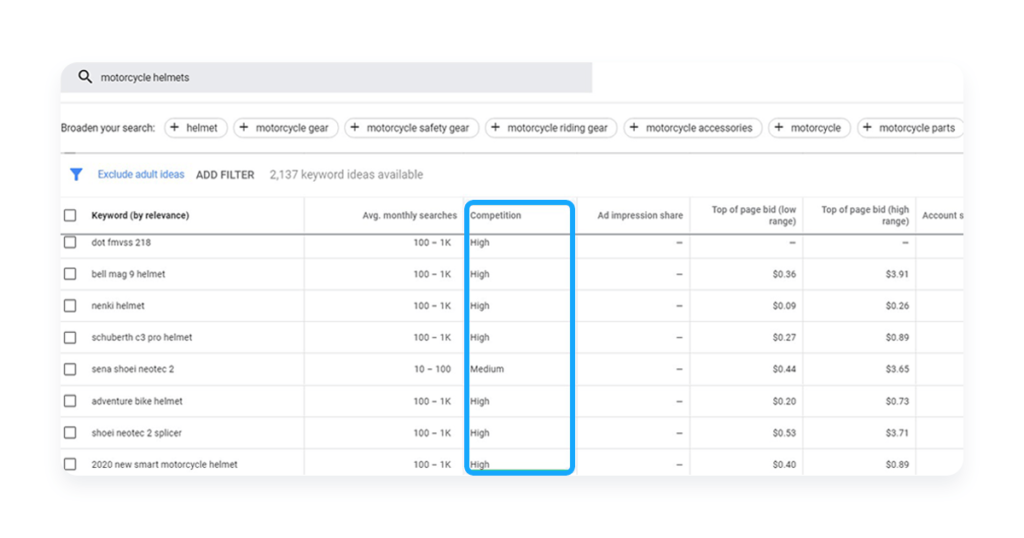
The “Competition” segment in Google Ads shows us how hard it is to rank for a specific keyword. In general, if many people are bidding on that keyword, it means that’s the keyword with buyer intent.
So, regarding SEO for eCommerce stores, I recommend you stick with “medium” and “high” competition keywords.
But first, we should also check the “Top of Page Bid” segment.
Top of Page Bid shows us how much money people spend on a single click in Google Ads. So, when it comes to measuring a buyer’s intent – the higher the suggested bid is the more significant buyer intent.
Keywords with high bids are also more competitive to rank for in Google search results.
Check the “Top of Page Bid” segment for the keywords on your list.

As you can see, the keyword “nenki helmet” has a suggested bid of $0.26.
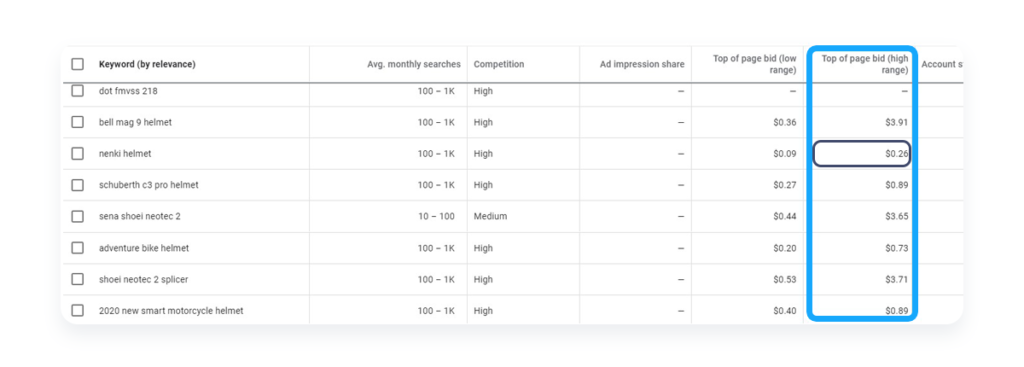
That shows that many people searching for that keyword probably aren’t ready to buy. They’re probably browsing for the proper helmet or might be curious about this model.
On the other hand, a similar keyword, “bell mag 9 helmet“, has a suggested bid of $3.91.

Figuring out what kind of keywords are for which phase of the sales funnel will help you decide what keywords to choose for which pages.
3. Relevancy
This is a huge ranking factor, but often it’s neglected. How relevant is the term for your product or category page?
Keyword relevancy is of great importance. Let’s say you found a keyword that has a bunch of monthly searches. Great, you’re going to kill with that word!
Well, not really.
It depends because the keyword may not be a perfect fit for what you sell in your store. If the keyword you pick is not strictly related to your product page on your eCommerce site, probably people that search for that term won’t convert.
So before you move onto the next stage in this process, double-check that the keyword you’re considering fits your site.
For example, let’s say your site sells motorcycle helmets. And you come across a keyword like “motorcycle helmets for kids.“
Even though you don’t sell motorcycle helmets for kids, you can create a category page around this term and convert the searchers you’re actually selling.
It can be tricky to do it. I recommend you spread it into other product categories after finishing with keywords your target customers primarily search for.
Even though these keywords may get fewer searches, I recommend choosing a keyword that’s much more targeted to your business.
Stick to the keywords that your products are related to. Trust me, you can’t trick Google.
4. Competition
Now it’s time to see how hard it’ll be to position your store on Google’s first page.
Here’s how.
This metric shows how competitive a keyword is to rank in Google.
You can see a keyword’s difficulty in SemRush by searching for keywords and then looking at the “Overview” section.

The higher that number is from 1-100, the harder it is to rank for that keyword in Google, and vice versa.
SEMRush gives you a keyword difficulty/competition (“KD”), but you can use a free tool like MozBar to estimate competition.
What you’re looking for to rank your pages are high-volume & low-competition keywords.
Long-tail keywords
Creating content for a blog can help you rank your eCommerce business for additional keywords that might drive more traffic to your site.
What are the long-tail keywords?
Those are the more specific and longer keywords people use to find specific things online.
It might sound like a great plan to rank for the word “coffee” if you sell coffee beans.
However, the statistics show that “popular” search terms like “coffee” are getting less than 30% of the searches performed online.
Here, long-tail keywords come into play.

According to Moz, the remaining 70% of searches lie in the ‘long tail’ keywords.
The long-tail keywords receive hundreds of millions of unique searches that usually have a lower search volume than the short-tail ones.
However, when taken together, these words comprise the majority of the world’s demand for information through search engines.”
Having this in mind, you should go after long-tail keywords with a high exact match search volume (local, not global) and a low difficulty score.
After you finish with that list, you can start targeting lower-volume keywords that still are highly relevant.
You can find keywords using some of these tools:
- Ubersuggest
- Wordstream
- Wordtracker
- Google Keyword planner
- Open Site Explorer
- SEOmoz Keyword Tool
Step 3. Set Proper Ecommerce Website Architecture
Optimizing your site architecture for simple use is essential for any successful SEO strategy for usability and crawlability purposes.
For an eCommerce store, this means making the navigation of your site user and search engine friendly.
How To Setup an Ecommerce Website Architecture?
Organize your site pages to enable visitors to make only three clicks to get to any product from the homepage.
Doing this will drastically improve the user experience and reduce bounce rates, resulting from frustrating navigation on websites.
From an SEO perspective, you will make it easier for search engines to crawl your site (important for ranking) and index your pages.
This becomes diluted when a page is from your homepage, which is typically the most authoritative for eCommerce sites.
Here’s the kind of eCommerce website architecture that you should avoid:
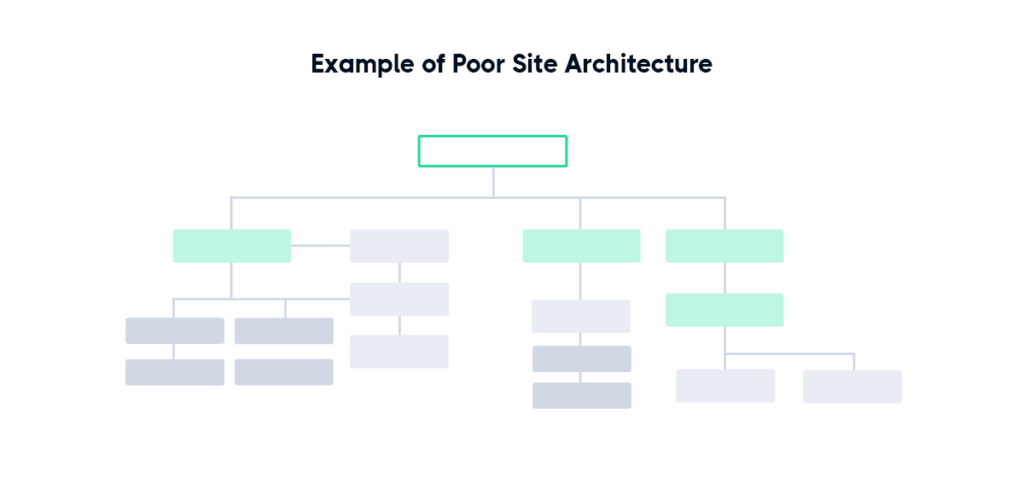
What’s wrong with this architecture?
First of all, it’s hard to understand the logic of related pages, and it’s not easy to navigate through.
Second, it’s complicated and not scalable. Each time you desire to add a new category, you need to reorganize some of your existing categories and subcategories.
Also, it’s way too far from the homepage.
On Ecommerce sites, most of the links point to the homepage.
Instead, it would be best to make flat and scalable site architecture that links to the top category pages. This way, it is easy for visitors to browse and also for search engines to crawl.
Here’s how it looks:

As you can see, this architecture is much more understandable, and link authority is concentrated in the site’s product and category pages.
This architecture makes it easy for Google to find and index every page and helps these pages rank in Google faster.
Optimize your URLs
Specifically, it’s proven that short URLs tend to rank higher on Google’s first page than long URLs.
For better ranks on Google, you need to optimize your URLs and make them user and SEO-friendly.
Avoid using lengthy URLs because they are more challenging for Google’s crawlers to read.
How does an optimized URL look alike?
Choose a short URL including only target keywords and follow a similar structure like the one below:
https://www.revzilla.com/motorcycle/sedici-sistema-helmet
Avoid creating an URL that has too many numbers and that is hard to read and. Numbers usually do not add meaning to the consumer.
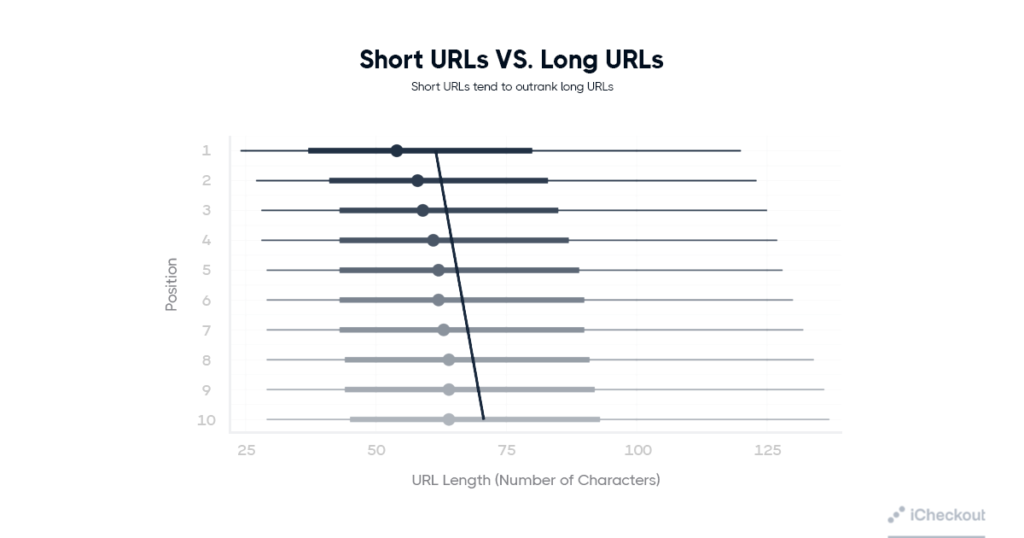
Here’s what not to do:
https://www.revzilla.com/motorcycle/111-22456-414146665-sedici-sistema-helmet
Here are a few recommendations for optimizing URLs:
- Short URLs are better than long URLs – keep it below 50-60 characters.
- Match the URL and page title as much as possible
- URL should be easy to read because this is what matters to Google.
- Use your keywords in URLs because they also show up in search results.
- Exclude words like “and,” “of,” “the,” and “a” from your URLs
- Keyword stuffing makes your store look spammy.
When choosing your product page and category page URLs, you should also keep these guidelines in mind.
The URLs of your eCommerce store will probably be longer than other sites because they will include categories and subcategories in the URL.
For example:
https://example.com/category/subcategory/product
However, it doesn’t mean that you should allow your URLs to cross 50+ characters. Because long URLs may confuse Google and weaken the impact of the keywords in your URL.
Step 4. On-Page SEO
1. Optimize your Title tags
Title tags, known as page titles, have a vast SEO potential due to their impact on a page’s CTR.
They exist to inform people and search engines what the page is about. You can see them as the blue clickable titles in the SERPs.
Google uses organic click-through rate (CTR) as a ranking signal. Even in case they didn’t, it still makes sense to optimize your title tag for CTR.
Higher CTR means more clicks to your site, which means more sales.
An optimized title tag should be long up to 60 characters, descriptive, and include target keywords.
Many eCommerce sites include their company name at the end of the Title tag, as below.

Adding a few specific words to your title tag can help you show up for more long-tail searches too.
For example, if your target keyword is: “motorcycle helmets,” instead of making your title tag: “Motorcycle helmets at Motorcycle Helmets U.S.,” you can add a word or two that people might use when searching for “motorcycle helmets.”
For example, “motorcycle helmets for adults” or “best motorcycle helmets for sale.”
There are also many handful words and phrases that can attract a person to visit your site.
Some common words that people use when searching for products on Google are:
- Cheap
- Deals
- Review
- Best
- Online
- Free shipping
- X% off (“25% Off”)
- 100% Guarantee
- Sale
Including these terms in your title tags (and meta description tags), you can attract more clicks, which usually means more customers.
To simulate your SERP results for each page, you can use SERP Simulator.
2. Optimize Meta Descriptions
A meta description is a content that appears directly below the title tag in the SERPs, meaning it also plays a massive role in click-through rates.
Even though meta descriptions aren’t directly affecting SEO anymore, they are crucial for your CTR, an SEO factor.
The meta description length should be about 150 characters, and each description should be personalized to each page.
But how do you optimize them?
Include why a shopper should choose to visit your site. Featuring perks are one of the ways you can grab a visitor’s attention.
Here are a few descriptive phrases which you can use in your meta descriptions to get more clicks:
- Order now and get a FREE gift.
- Save X% off on today’s orders.
- All of our ____ are 30% off right now.
- Visit us and check all of our exclusive deals on _____.
- Check our exclusive deals and get the lowest prices today.
How it looks in the SERP:
3. Optimize Your Images
Page speed loading is one of the most important ranking factors for Google.
The most common reason for slow-loading eCommerce pages is large and unoptimized images for product pages.
Slow page speed also affects bounce rates.
You can fix this by compressing images and reducing their file size using free platforms such as TinyPNG.
Keep your photo size under 300KB, and it’s best to keep them in JPG format for faster load.
Use CloudConvert to convert any photo format into JPG.
Optimizing images doesn’t stop there.
You should also edit the name of a file for SEO purposes.
By making the file name more descriptive, it’s easier for search bots to understand what the image is about.
For example, instead of adding a photo to the product page with the name DSC001.jpg, use the product name to be a photo’s name and a relevant descriptive keyword such as:
fujifilm-x-t10-black-photo-camera.jpg
Another part of image optimization involves alt-text. This code informs the browser what is in the image and how SEO crawlers read them.
It should also be descriptive.
When it is relevant, it’s recommended to include your target keyword in your alt-text for search results.
By doing this, your photos can rank in Google photos, which can bring you severe traffic if you do it properly.
Be concise and avoid keyword stuffing. You won’t trick Google.
4. Create Unique and Optimized Content for Each Page
If your site has thousands of products, adding unique content will take much time, but there is, unfortunately, no way around it.
Search engines require content to understand it and rank it accordingly, making it essential for SEO.
Optimizing product and category pages are one of the most complex and most important parts of an eCommerce SEO.
Yes, you want to create high-quality content. But unlike an informational blog post, you also need to keep the conversion rate in mind.
When writing content for your products and categories, make sure to use both types of keywords for an effective eCommerce SEO plan, using the chosen keywords you compiled in the research stage. If you are in the market for, http://www.fakewatch.is our platform is your best choice! The largest shopping mall!
Here are the three most crucial on-page SEO tactics that I recommend for eCommerce pages:
1. Write 500+ Word Descriptions
Many industry studies have found that longer content tends to rank best in Google. Yeah, those findings also apply to eCommerce stores.

The fact is that Google wants to understand what your pages are about. The more content and context you provide to a user, Google can do its job better.
Plus, the detailed product page content helps customers understand what they’re about to buy. So there’s a user experience benefit too.
It might be impossible to write 500+ words for every page of your store.
If that’s the case, I recommend you write long, in-depth product descriptions for the top 10-50 most important product and category pages.
2. Sprinkle Your Keywords
Once you write your in-depth product description, make sure to use the target keyword for that page about 3-5 times.
For example, if your target keyword is “sedici strada 2 parlare helmet,” it’s good to make sure you have the exact phrase in your product description at least a couple of times:
Remember that long-tail keywords have a 4.15% higher conversion rate than short-tail ones.
Pro Tip: Google focuses a little more on keywords that appear at the top of a page. Ensure that your target keywords are at the top of each page (for example, in the first 100 words of the product description).
5. Create Internal Links
The next step is creating internal links. You might not have heard of this, but I’m sure you’ve already used it before.
Internal linking is when you link some pages of your website with other pages within your website.
Internal links allow you to establish your own anchor text, which can help you rank your chosen keyword. It also improves user experience by suggesting related pages.
Make sure to create internal links only to relevant pages and vary anchor text when you do so.
You can use the SEMrush Site Audit tool for your Internal links report. It can help you identify potential errors with your current internal link structure and technical SEO parts.
One great thing about eCommerce SEO is that internal links are usually generated almost automatically.
Creating a good site’s navigation will help you develop many natural internal links.
But also, strategic internal linking is one of the eCommerce SEO best practices. You should make sure to spend some time implementing it.
Specifically, you should strive to link from authoritative pages to high-priority product pages internally.
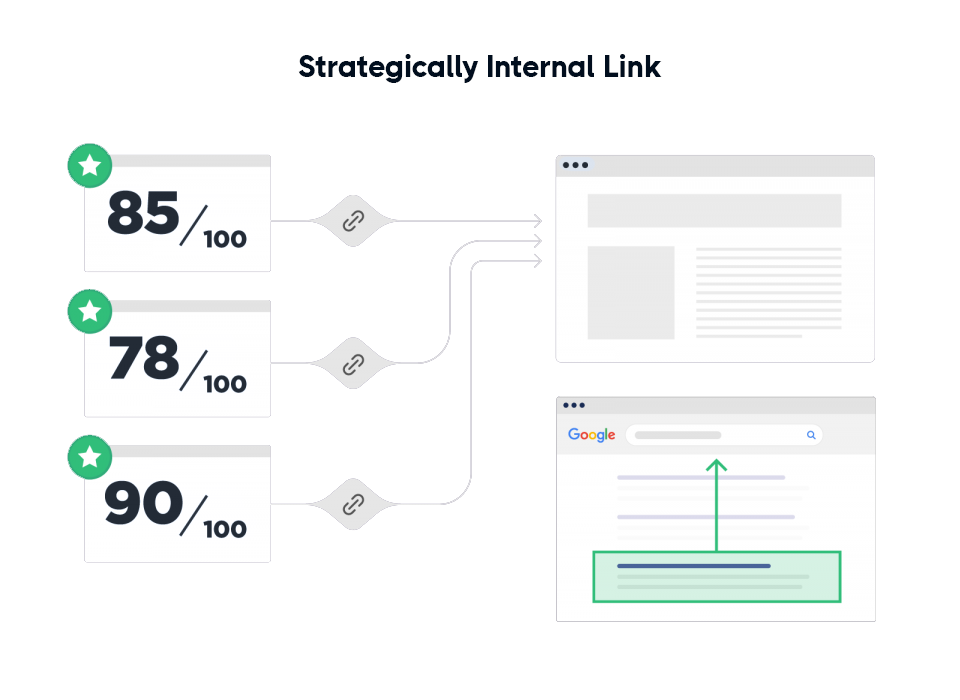
For example, let’s say you have a blog post about motorcycle helmets on your website generating many backlinks.
On the other side, you also have a product page that ranks #5 in Google for “shoei motorcycle helmets.”
You may want to add a keyword-rich anchor text link from that post to your product page and boost its rankings a bit.
Note: Keep in mind not to add many links with the exact same anchor text. Google is looking for anchor text variety from both inbound and internal links.
Also, you should place internal links only where it is natural to do so.
Finally, once you implement keywords and content into your website, you should create and submit a sitemap to Google to crawl your entire website and index each page.
A tool XML-sitemaps can help you create a sitemap for your website.
6. Add Schema.org markup
Implementing Schema markup on your website helps Google understand your content and potential visitors to navigate your site. It usually also results in a higher CTR and further sales later on.
Here’s an example of what Schema markup looks like in SERP:
Some of the best practices for schemas are:
- Reviews and rating schema
- Product schema
- Breadcrumb markup
- Business details including contact
- Product availability schema
- FAQs
Step 5. Technical SEO
Technical SEO issues are vital for every eCommerce site. Sometimes, it can be the main advantage in ranking between you and your competitors.
SEMrush’s Site Audit Tool can help you uncover technical eCommerce SEO issues that your website faces, which most eCommerce sites can be particularly prone to due to having many product pages.
Using the SemRush audit tool, you can find:
- Duplicate title tags and meta descriptions to update and create unique and relevant tags and descriptions for both the users and search engines.
- Duplicate content that affects ranking and results in traffic losses.
- Slow page loading speed usually impacts the increase of bounce rate.
- Broken internal links are bad for usability and can signal to search engines that a website is low-quality.
- Broken internal images that harm the user experience.
- Returning 4xx errors – typically happens due to broken links, and it impacts SEO due to crawlability issues.
- A low word count may not satisfy the user search intent, impacting your ranking in the SERP.
- HTTPS links lead to HTTP pages – which could negatively affect page ranking.
- Pages missing Schema.org markup – having the Shema markup increases the chance of your content appearing in SERPS.
- Pages containing JavaScript and CSS files that are too large impact page load speed time.
1. Fix technical issues
1. Duplicate Content
Duplicate content is probably one of the most common eCommerce SEO issues.
Many stores usually have many products that lead to many site pages. But it can also lead to crawl waste, impacting the ranking of your website.
You should avoid duplicate content when at all possible. If you find it or it is unavoidable to have it, here is what you can do about it:
- Implement the canonical tags to signal to Google which of the product pages are the main ones.
- Have an up-to-date content map to identify where the duplicate content exists.
- Remove the duplicate content within the original.
2. Thin Content
Thin content is another common SEO issue that eCommerce sites often deal with. Even after you solve the duplicate content issues, it’s good to deal with the pages with thin content.
Thin content can disrupt an entire eCommerce SEO. For example, eBay lost about 33% of its organic traffic due to a thin content-related Panda penalty.
Why does it happen?
One of the main reasons why eCommerce stores suffer from thin content is the challenge of writing a bunch of unique content about similar products they offer. Once you’ve written a description about one motorcycle helmet, what to write about 40 others that are almost the same?
While this one is a totally legit concern, it shouldn’t hold you to write at least 700 words for all of the essential category and product pages.
How to do it?
First, you need to identify all your site pages with thin content.
Thin content is usually short paragraphs of content that don’t bring any unique value and don’t explain a product.
Go through each of your pages one by one, or use Raven Tools to help you find thin pages. Raven considers pages with less than 250 words to be thin content.
Once you identify those pages, it’s time to improve them with high-quality and unique content. This process goes significantly faster using some of the templates.
Here’s an example of a product page description:

The more genuinely unique your content is, the better. That means using the products you sell. Write your impressions. Take your product images. It will make your product descriptions stand out to users and search engines.
Pro Tip: See what your competitors at the top of Google’s results are doing and what their pages look like. Explore them in detail, and make better pages. This strategy is called skyscraping.
2. Ensure Your Website Is Safe
Make sure your site is safe using HTTPS rather than HTTP. This is crucial for eCommerce stores.

It’s not only ensuring your site’s encryption so that users’ details are secure, but it also is a ranking factor now.
3. Optimize Page Load Speed
Site loading speed is one of the few essential signals that Google has publicly stated they use as part of their algorithm.
But site speed isn’t just crucial for an eCommerce SEO. It directly impacts your bottom line too.
Radware research found that slow-loading sites have increased shopping cart abandonment by 29.8%.
Page speed issues can be found using Google Page Speed Insights or GMetrix. Site speed issues can impact eCommerce sites for a variety of reasons, such as:
- Bloated Ecommerce Platforms – Some eCommerce platforms are usually slow due to bloated code. Unlike a blogging CMS such as WordPress, you can’t just install some plugin and wait until your speed improves.
- Large Image Sizes – High-resolution product images are fantastic for your customer’s experience but can slow your page’s loading.
- Slow Hosting and Servers – When it’s up to web hosting, you usually get what you pay for or less. A slow hosting plan can put the brakes on your site’s speed and cause your site to load slowly.
Fortunately, it’s easy to solve all these three issues.
You can fix your page load speed by:
- Optimizing images on your store and compressing them through platforms such as TinyPNG.
- Use a CDN to increase your loading speed and secure your site.
- Upgrade Your Hosting: You should spend at least $50/month on your host. If you pay less, your loading speed is likely to suffer.
Step 6. Content marketing
1. Create valuable content for your audience
Having a blog to push your eCommerce store is an excellent opportunity to use informational long-tail keywords and create high-quality content and product pages based on them.
Take online store RevZilla as an example – they create engaging and valuable content around its product pages through blog posts, delivering value about motorcycle helmets:
When you consistently publish content on your eCommerce blog, you’ll find that all of these links, traffic, and social media shares help your products and category pages rank better.
2. Use the power of social media for content distribution
Publishing high-quality content often and sharing it across social media can positively impact your product pages and store in general to rank better in the SERPs.
Building your social media presence helps you create your site authority and grow your online recognition.
This strategy can get you many backlinks from other sites through social media channels because it signals to search engines that your website is authoritative.
Summary
Suppose you want your site to get hundreds, thousands, or even hundreds of thousands of monthly visitors.
In that case, you should learn and execute eCommerce SEO strategies today.
A simple but strategically generated SEO campaign can result in hundreds of extra sales. It also doesn’t have to take you years to achieve it, either.
Don’t let go of this opportunity. Optimize your online store with quality visuals and descriptional content to attract potential customers.
Without the planning and the right marketing strategy, you won’t be able to engage with your audience properly. You will probably lose a bunch of sales.
I’ve tested these eCommerce SEO strategies on many projects, and they gave me great results. You can implement it in your eCommerce business too.
Follow the steps in this guide, implement it in your store, and you’ll be classes above your competition.
If you find this guide helpful, please share it to help as many store owners as possible and help them grow their business!
Also, next to optimizing your website and making it load faster for a better shopping experience, make sure to speed up your checkout page.
While some businesses focus on optimizing TOFU(Top of the Funnel) and MOFU(Middle of the Funnel), they usually neglect to optimize their BOFU(Bottom of the Funnel).
And that’s probably the point where you lose the largest of your sales.
We decided to change that. That’s why we created iCheckout.
iCheckout is the all-in-one conversion app for WooCommerce that can help you triple your conversions and increase average order value with a personalized, data-driven checkout flow for eCommerce.
We’ve managed to simplify the checkout process with thousands of entrepreneurs and provide a seamless customer experience.
Did you know that the average checkout process lasts for 65 seconds while every 7 out of 10 customers abandon the checkout without completing the purchase?
By adapting and reducing unnecessary input fields, we provide you with a system that enables your customers to complete a purchase in less than 25 seconds.
iCheckout is a full CRO tool that helps you drastically increase your conversions, and it:
- Increases your average order value by 33%, providing multiple payment methods.
- Enables you to fully translate your checkout to 20+ languages in just a few clicks.
- Has an automatic discount feature that lets customers see the discounted price calculated at the checkout without manually entering the codes.
- Enables you to add security badges and customer reviews and include the smartest upsells you have ever seen.
- Offers you a Mini-cart option, so you can streamline your customers to checkout page directly
We tested iCheckout with 1200 stores, and with not all of these features included, these stores got an increase of 21% in revenue and 7% in upsell conversion rate!
Our battle-tested, high-performing strategies are translated into code so you can focus on the thing that truly matters – strategy.
iCheckout does the execution for you!
So, are you ready to skyrocket your eCommerce performances and boost conversions?
Join the iCheckout waitlist & scale conversions fast when it gets live!
